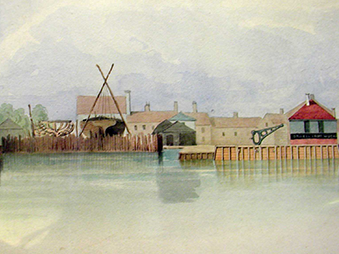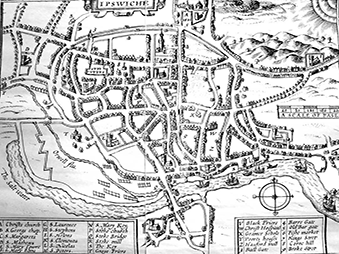Borough records relate to their own burgage tenements and waste lands, and their records do not extend far beyond the area enclosed by the town walls and the suburbs.
Other lands within the liberty were held of the various manors. Land could be held of a manor as 'copyhold', a form of tenure finally abolished in 1922. At each exchange of a property the former owners had to surrender their lands back to the lordship of the manor before the new owners could take possession. The exchanges were recorded at the manorial courts and entered into the manor court books and earlier rolls. Most court books record the date of the previous transfer but before 1733, apart from the period 1653-1660, the records were written in Latin.
The records for the various manors should be listed on the National Archives ‘Manorial Documents Register’.
The records for Suffolk have been recently updated but there is an omission in that the records of the Manor of Stoke, part of the Ely Diocesan Church Commissioners Records held at Cambridge University Library, are at present not listed on the register.
The records dating from 1653 have been copied on microfilm and are available at Ipswich. The earliest record is a survey made c.1653 and annotated up until 1689. The survey gives a description of each piece and then records the previous owners from earlier records that are no longer existing. The earlier references begin in about 1464.
Manors of Stoke, Wix Bishop and Wix Ufford
There is also in the Library Collection a manuscript ‘Manor of Stoke Copies of Terriers Extracts from Court Rolls etc c 1540-1651’ which appears to relate to other records that are no longer existing (ref. 333.3220942649).
The lands of the manor of Wix Bishop were mainly with the parish of St Clements. The records have been used extensively in archaeological reports on Holywell Park and the areas of Ipswich’s Docks within that parish.
Nearly all the former copyhold lands of the manor of Wix Ufford had been granted out at the end of the medieval period and the manor court was only held to record the exchanges of the insignificant remnant of the former estate. A part of a rental of 1552 was published in Copinger’s ‘Manors of Suffolk’ and the original document is in the Iveagh Collection (ref. HD 1538/274/32). The lands were mainly in the parishes of St Helens and St Clements and some appear to have been interspersed by lands held of Wix Bishop. There is an earlier rental dated 1475-1500 (ref. HA 231/2/11).
Manor of Christchurch
The manor of Christchurch inherited the former lands of the Priory of Holy Trinity. All but one of the court books from 1653 have survived and are now held at Ipswich. Each is indexed. The lands were mainly within the parish of St Margaret’s but there were also tenements elsewhere within the borough. Both the freehold and copyhold are listed in a rental of 1546 (ref. HD 1538/271/7). It is possible that this manor had been granted to the Priory of Holy Trinity but the foundation charters for that priory are lost. The medieval court rolls are assumed to be records of the Priory and not the manor. In the early nineteenth century the rolls were held at Christchurch Mansion but are now divided between those held in Ipswich and others at the British Library.
The two surviving late thirteenth century rentals of the Priory of Holy Trinity were published in 1847 (Hunt) and the entries can be cross-referenced to show a succession of owners which can be linked to various parishes.
Manor of St Peter’s
Though there are references to the lord of the manor of St Peter’s, no post medieval records are known to have survived. David Allen who produced the ‘Catalogue of the Archives of the Borough of Ipswich’ (SRS 2000) is preparing an edition of the cartulary of the Priory of St Peter and St Paul for publication (ref. HD 226/1). This manuscript (ref. HD226/1), formerly held at Lexington Library, Kentucky, is a collection of the early transactions or charters of the former priory. It is incomplete and in particular there is a distinct lack of entries relating to the priory’s possessions in Ipswich, apart from the charters for Handford Mill. The cartulary contains a record of a dispute over the rights of presentations to St Clements between the heirs of the church’s founder Rothulf and the priory. The inquisition that determined this dispute was held in 1254 and not in 1201 as has been previously suggested (Breen 2010). The error has appeared in some archaeological reports. The published work will include a collection of all the known medieval charters of the priory.
A significant number of these charters relating to lands in St Peters, St Nicholas and the former parish of St Augustine’s are held at the National Archives (ref. E40). These were collected together in the Cardinal’s Bundles when the priory was dissolved to finance Cardinal Wolsey’s Ipswich College. There is a rental of the priory’s possessions dated 1516 held at Manchester University John Rylands Library (ref. CRU/175). There are also two post-dissolution rentals held at the National Archives (ref. SC12/15/14 and SC 11/616).
Bigod’s Quay and the manor of Walton cum Trimley
Part of Bigod’s Quay in the parish of St Mary's Quay was held until the late nineteenth century of the manor of Walton cum Trimley. The ownership of the quay can be traced in the manorial records back to 1397 (Ref HA119:50/3/18 m 73). It can be traced further in other sources back to the death of Roger le Bygod (Bigod), earl of Norfolk in 1270. Even if these records did not exist, the fact that the quay was part of the possessions of the manor of Walton with Trimley shows that it pre-dates the establishment of the borough.


